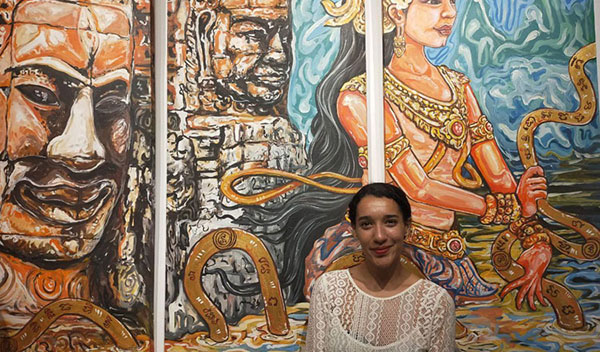ArtsEquator’s Southeast Asia Radar features articles and posts about arts and culture in Southeast Asia, drawn from local and regional websites and publications – aggregated content from outside sources, so we are exposed to a multitude of voices in the region. In the weekly Southeast Asia Radar, we publish a round-up of content that have been scoured and sifted from a range of regional news websites, blogs and media platforms.
Here is this week’s Southeast Asia Radar:

Art is for everyone, the Cendana way
The Malaysian Reserve
“Last year, during the Budget 2020 announcement, RM5 million has also been allocated to Cendana to support art exhibition organisers and visual art galleries to hold their art displays.
“From our past two years of experience, more than 50% of our grant actually goes to performing arts. Then, there’s 24% for visual arts and 25% for music. So, based on our experience, out of the 24%, most of the funding is given to support visual artists, in terms of their mobility,” she said.
Cendana also gives local artists the opportunity to fund a residency or a fair.
“We have also used the same funding programme to support established artists like Fuad Osman to partake in the Sharjah Biennial.”

A way with words: Painter Jumaldi Alfi presents solo exhibition in Yogyakarta
Jakarta Post, Indonesia
““In all honesty, I still think my work is still far from [good] contemporary art. But if that’s how the public sees it, I’m fine with that,” Alfi said during the exhibition’s opening on Jan. 21.
He said his style of painting was adjusted to his need to express his thoughts. “I grew up in a Minang culture with hardly any visual references, unlike the Javanese which had wayang or batik. So when I try to express my ideas onto a canvas, I tend to ‘speak’ verbally or through texts,” he said.”

Kingdom’s urban art flourishes at annual festival
Khmer Times, Cambodia
““Unfortunately, the idea surrounding art here is still very elitist. People don’t want to go to an art gallery because they cannot afford the pieces there. When we do events like this, people show up because art is viewed as something fun for all,” she elaborated.
“Personally, when I build this gallery, I don’t want art pieces to just be on the wall. I want a space to create art, to have people react and be emotionally affected by art. When you are here and interacting with art, you are already a part of the urban art movement.”

Rohingya refugee writers dial into Myanmar poetry slam
Frontier Myanmar
“YANGON — Divided by hatred but united over the written word, Rohingya Muslim poets in Bangladeshi refugee camps joined Buddhist bards in Myanmar by video link as part of a groundbreaking poetry festival in a country reeling from genocide allegations.
Five Rohingya writers took part in the three-day “Poetry for Humanity” event in Yangon, with three speaking live by video link to a packed room while two had sent pre-recorded readings, fearing their stuttering connection would not hold up.
They drew applause for verses on the bloodshed that forced hundreds of thousands of Rohingya to flee their homes in northern Rakhine State, and also for their resilience.”

Singaporean rapper BGourd on his green suit, debut EP ‘Veggie Wraps Vol. 1’, and North East Social Club
Buro Singapore
“How did BGourd come about?
BGourd: I started about three years ago. BGourd is short for bitter gourd because, metaphorically, bitter gourd is a vegetable that not a lot of people like. It’s an acquired taste, right? I expected that my music would also be an acquired taste. My first EP, Veggie Wraps Vol. 1, was released in early Jan and is a quick ease in.
Everyone is probably wondering if there’s any significance to the whole green suit.
BGourd: I would reference Canadian socialogist Erving Goffman in The Presentation of Life and Everyday Self. It’s about putting a different face forward when I’m on stage and taking it off like a mask when I’m done. Everyone has masks in different social situations and I wanted this mask to be very clear. There’s no ambiguity; this is who I am when I rap; I am Bgourd. It’s also pays homage to MF Doom. I made the first suit I wore, but I’ve found one that has nice cut-outs.”

55 Balete: The studio where Pinoy comic book legends were made
CNN Philippines
“Just a year ago, California-based artist Whilce Portacio said it was his dream to reunite the powerhouse comic book team he built in 1994, a studio called Starfire Visuals, then located on 55 Balete Drive in Quezon City.
Last October, Portacio was back in Manila to see this dream happen through SuperManila — the pop culture convention that’s practically a reunion organized in his honor.
“I wish we had digital cameras back then,” says Portacio, “to document all the things we had, all the stars that hung out, all the events. We started a lot of things. We did comics, movie posters, record album covers… It’s really nice to see that it’s still happening.””

Hip-hop’s fresh, new voice
Bangkok Post
“Equally ingenious is Lan Neung [One Million], which sees Tang and the same hype man from the previous track reimagining facetious telephone conversations based on a true-crime story whereby a group of hitmen are jailed after trying to subcontract a job to each other. After two dialogue-driven offerings, he ends the EP on a high note with Tang Arai, a parody of autobiographical hip-hop tracks. “Pinching a dog … Pushing a dude in a Winnie the Pooh costume/ Reciting Thai alphabets my own way?/ Man, I’ve done it all,” he raps, rattling off a litany of badass feats from the perspective of a fourth-grader.”

